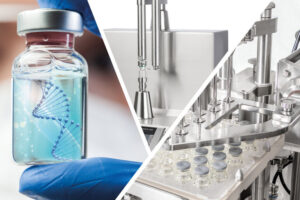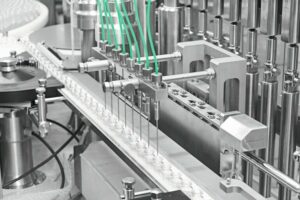Process Analytical Technology (PAT) is the buzzword in the pharmaceutical industry. The guideline “PAT – A Framework for Innovative Pharmaceutical Development, Manufacturing and Quality Assurance”, put forward by the FDA, calls for a system for the design, analysis and control of pharmaceutical production, which serves as a basis for increasing the efficiency of pharmaceutical production processes. cpp talked to Dr. Frank Stieneker, Managing Director of the Association for Pharmaceutical Technology (APV e. V.), about the influence of PAT on production processes and plants.
cpp: Which are the challenges the pharmaceutical industry is currently facing in your opinion?
Dr. Stieneker: The quality of pharmaceuticals, essential to their safety, has always been the most important requirement made on the pharmaceutical industry. This was first established with the inclusion of the GMP guidelines in international regulations. The introduction of GMP about 30 years ago and its ongoing evolution (including everything falling under the term “GxP”) has on the one hand resulted in many improvements with regard to drug safety, but on the other hand generated quality control and assurance departments, which are twice as big as the production departments. One of the working groups of the FDA analysed these developments and came to the conclusion that the incremental improvements in drug safety fall far short of keeping pace with the rising costs in the fields of quality control, safety and management.
cpp: How can the problem be solved?
Dr. Stieneker: In order to stop this increase in production costs, or possibly even reverse it, yet continue improving drug quality, a new approach is presently being developed. Validated, stable production processes will necessarily lead to products of the required quality, with the result that the statistical quality control and subsequent release of the end product can be performed more efficiently. The goal is parametric production control and product release. This approach, that is to say, process stability in pharmaceutical production, is currently being discussed under the term PAT (Process Analytical Technology) and is regarded as the challenge of the coming years. In discussions about PAT for the pharmaceutical industry, however, it is often forgotten that parametric control of a production process with subsequent parametric release of the end product is old hat for other process industries and that by looking beyond our own noses we could actually make the transition to the PAT paradigm much easier.
cpp: What are the advantages of introducing PAT?
Dr. Stieneker: Generally, PAT can be considered a tool to improve the stability of production processes, ensuring product quality by means of these processes. Looking at it more closely, however, PAT provides a way to continuously improve the flexibility of production lines and processes while at the same time getting a grip on the problem of decreasing batch sizes and increasing numbers of product variants. In other words, PAT – if applied sensibly – could be a first step towards continuous flow production, and could consequently represent an essential module for pull production and thus for tailoring product planning to the market and its needs. The consistent implementation of PAT will require fundamental adaptations on the part of the pharmaceutical industry, which will be rewarded with substantial improvements in the efficiency of pharmaceutical manufacturing in the medium and long term.
cpp: How is PAT put into practice?
Dr. Stieneker: At the moment, the discussion is heading in a different direction. PAT is often viewed as a tool to bring quality control to the line. The frequent mention of NIR (near infrared spectroscopy) can be stated as an example. With this method, the 100 % inspection of the end product is supposed to abolish the necessity for the release by the quality control department. Those who support this procedure point to the improvement in product quality, which is certainly correct – but the downside is the considerable increase in resources required for testing, which runs contrary to the PAT aim of reducing the overall quality control effort.
cpp: What kind of measures do you suggest?
Dr. Stieneker: It would be more appropriate for the operator of a production line to screen production parameters as a first step. These parameters would then have to be evaluated with regard to the following criteria:
- Does this parameter influence the quali-ty of the product directly or indirectly?
- Can this parameter serve as a control element in a control loop?
- Does the measuring method itself impair the quality of the product under certain circumstances?
- Do tolerances of different parameters possibly have an additive, multiplica-tive or even exponential influence on quality?
In a second step, the loops necessary to control the production lines would need to be defined in real time. These control loops would have to be as small as pos-sible to enable each individual process step to be controlled quickly and accurately. As soon as the production line operates under the control of these loops, a longer optimisation phase will have to follow, in the course of which the limits of individual parameters will be redefined in the context of interactions with other parameters. In the automotive industry, “flexible standards” is established terminology. The way of proceeding is comparable to a continuous improvement process.
cpp: Does this require significant modification of the production lines?
Dr. Stieneker: The development of production lines under the influence of PAT is interesting. Single-purpose equipment certainly does not pose the same challenge as equipment, which must be employed flexibly for different products. Yet it is exactly this versatility, which constitutes one of the future requirements of the pharmaceutical industry, for example to exploit the advantages of PAT regarding efficient production in line with market needs against the background of pull production for smaller batch sizes. Consistent implementation of PAT requires parametric control of the process in real time. A great number of novel sensors must be incorporated into the production line design to meet the demand for modular control loops to control the production lines. These modular loops and line components must be switched on or off (or installed/removed) to control the process in accordance with the products to be manufactured and ensure the requested flexibility of the production facility. The loops should be controlled with the aid of sensors that record product parameters along the line or alternatively acquire equipment data. In an ideal situation the sensors are part of the modular line components and can be replaced with them.
cpp: What are the consequences for the operator?
Dr. Stieneker: This approach has a significant impact on the amount of work required to qualify the production lines as well as on measuring and control systems. Intelligent modular systems with intelligent qualification concepts must ensure that the advantages of PAT – reduced effort for validation and quality control – are not nullified by an increased qualification demand. If all the described requirements are fulfilled and the production process is able to meet the demands regarding product quality with sufficient reliability, a statistical quality control procedure will no longer be necessary and parametric release (real-time release) can be introduced, although in the case of pharmaceutical production this can only be done after altering the corresponding approval dossiers and, as the biggest hurdle, the regulatory framework. Against this background PAT will certainly remain a challenge in the next few decades.
cpp 453
APV
PATat FDA
6th World Meeting on Pharmaceutics, Biopharmaceutics and Pharmaceutical Technology
Share:








